Unconscious Processing of Greenery in the Tourism Context: A Breaking Continuous Flash Suppression Experiment
Abstract
1. Introduction
2. Tourism, Vacations, and Recovery
3. Materials and Methods
3.1. Breaking Continuous Flash Suppression: Measuring Unconscious Processing
3.2. Stimuli
4. Results
4.1. Experiment 1
4.1.1. Experimental Instruments and Materials
4.1.2. Participants and Procedure
4.1.3. Results
4.2. Experiment 2
4.2.1. Experimental Instruments and Materials
4.2.2. Participants and Procedure
4.2.3. Results
5. Discussion
5.1. Unconscious Processing Effects of Greenery
5.2. Limitations and Recommendations for Future Research
6. Conclusions
Author Contributions
Funding
Institutional Review Board Statement
Informed Consent Statement
Data Availability Statement
Conflicts of Interest
References
- Pearce, P.L. Travel Motivation, Benefits and Constraints to Destinations. In Destination Marketing and Management: Theories and Applications; CABI: London, UK, 2011; pp. 39–52. [Google Scholar]
- Staats, H.; Kieviet, A.; Hartig, T. Where to Recover from Attentional Fatigue: An Expectancy-Value Analysis of Environmental Preference. J. Environ. Psychol. 2003, 23, 147–157. [Google Scholar] [CrossRef]
- Bültmann, U.; Kant, I.J.; Schröer, C.A.P.; Kasl, S.V. The Relationship between Psychosocial Work Characteristics and Fatigue and Psychological Distress. Int. Arch. Occup. Environ. Health 2002, 75, 259–266. [Google Scholar] [CrossRef] [PubMed]
- Craig, A.; Cooper, R.E. Symptoms of Acute and Chronic Fatigue. In State and Trait; Elsevier: Amsterdam, The Netherlands, 1992; pp. 289–339. [Google Scholar]
- Sonnentag, S.; Geurts, S.A.E. Methodological Issues in Recovery Research. In Current Perspectives on Job-Stress Recovery; Emerald Group Publishing Limited: Bradford, UK, 2009; pp. 1–36. [Google Scholar]
- Lehto, X.; Kirillova, K.; Li, H.; Wu, W. A Cross-Cultural Validation of the Perceived Destination Restorative Qualities Scale: The Chinese Perspective. Asia Pac. J. Tour. Res. 2017, 22, 329–343. [Google Scholar] [CrossRef]
- Meijman, T.F.; Mulder, G. Psychological Aspects of Workload. In Handbook of Work and Organizational Psychology; Drenth, P., Thierry, H., Eds.; Psychology Press Hove: Hove, UK, 1998; pp. 5–33. [Google Scholar]
- Hobfoll, S.E. Conservation of Resources: A New Attempt at Conceptualizing Stress. Am. Psychol. 1989, 44, 513–524. [Google Scholar] [CrossRef]
- Kaplan, R.; Kaplan, S. The Experience of Nature: A Psychological Perspective; Cambridge University Press: Cambridge, UK, 1989. [Google Scholar]
- Laumann, K.; Gärling, T.; Stormark, K.M. Selective Attention and Heart Rate Responses to Natural and Urban Environments. J. Environ. Psychol. 2003, 23, 125–134. [Google Scholar] [CrossRef]
- Berman, M.G.; Jonides, J.; Kaplan, S. The Cognitive Benefits of Interacting with Nature. Psychol. Sci. 2008, 19, 1207–1212. [Google Scholar] [CrossRef] [PubMed]
- Gladwell, V.F.; Brown, D.K.; Barton, J.L.; Tarvainen, M.P.; Kuoppa, P.; Pretty, J.; Suddaby, J.M.; Sandercock, G.R.H. The Effects of Views of Nature on Autonomic Control. Eur. J. Appl. Physiol. 2012, 112, 3379–3386. [Google Scholar] [CrossRef]
- Kaplan, S. The Restorative Benefits of Nature: Toward an Integrative Framework. J. Environ. Psychol. 1995, 15, 169–182. [Google Scholar] [CrossRef]
- Maller, C.; Townsend, M.; Pryor, A.; Brown, P.; St Leger, L. Healthy Nature Healthy People’s Contact with Nature as an Upstream Health Promotion Intervention for Populations. Health Promot. Int. 2006, 21, 45–54. [Google Scholar] [CrossRef]
- Ulrich, R.S. View through a Window May Influence Recovery from Surgery. Science 1984, 224, 420–421. [Google Scholar] [CrossRef]
- Tennessen, C.M.; Cimprich, B. Views to Nature: Effects on Attention. J. Environ. Psychol. 1995, 15, 77–85. [Google Scholar] [CrossRef]
- Taylor, A.F.; Kuo, F.E.; Sullivan, W.C. Views of Nature and Self-Discipline: Evidence from Inner City Children. J. Environ. Psychol. 2002, 22, 49–63. [Google Scholar] [CrossRef]
- Kweon, B.S.; Ulrich, R.S.; Walker, V.D.; Tassinary, L.G. Anger and Stress: The Role of Landscape Posters in an Office Setting. Environ. Behav. 2008, 40, 355–381. [Google Scholar] [CrossRef]
- Lottrup, L.; Grahn, P.; Stigsdotter, U.K. Workplace Greenery and Perceived Level of Stress: Benefits of Access to a Green Outdoor Environment at the Workplace. Landsc. Urban Plan. 2013, 110, 5–11. [Google Scholar] [CrossRef]
- Wilson, E.O. Biophilia; Harvard University Press: Cambridge, MA, USA, 1984. [Google Scholar]
- Ulrich, R.S. The Biophilia Hypothesis; Island Press: Washington, DC, USA, 1993. [Google Scholar]
- Berto, R. Exposure to Restorative Environments Helps Restore Attentional Capacity. J. Environ. Psychol. 2005, 25, 249–259. [Google Scholar] [CrossRef]
- Ulrich, R.S.; Simons, R.F.; Losito, B.D.; Fiorito, E.; Miles, M.A.; Zelson, M. Stress Recovery during Exposure to Natural and Urban Environments. J. Environ. Psychol. 1991, 11, 201–230. [Google Scholar] [CrossRef]
- Lee, J.; Park, B.-J.; Tsunetsugu, Y.; Kagawa, T.; Miyazaki, Y. Restorative Effects of Viewing Real Forest Landscapes, Based on a Comparison with Urban Landscapes. Scand. J. For. Res. 2009, 24, 227–234. [Google Scholar] [CrossRef]
- Park, B.J.; Tsunetsugu, Y.; Kasetani, T.; Kagawa, T.; Miyazaki, Y. The Physiological Effects of Shinrin-Yoku (Taking in the Forest Atmosphere or Forest Bathing): Evidence from Field Experiments in 24 Forests across Japan. Environ. Health Prev. Med. 2010, 15, 18–26. [Google Scholar] [CrossRef]
- Kaplan, R. The Nature of the View from Home: Psychological Benefits. Environ. Behav. 2001, 33, 507–542. [Google Scholar] [CrossRef]
- Lin, Y.-H.; Tsai, C.-C.; Sullivan, W.C.; Chang, P.-J.; Chang, C.-Y. Does Awareness Effect the Restorative Function and Perception of Street Trees? Front. Psychol. 2014, 5, 906. [Google Scholar] [CrossRef]
- Stack, K.; Shultis, J. Implications of Attention Restoration Theory for Leisure Planners and Managers. Leisure 2013, 37, 1–16. [Google Scholar] [CrossRef]
- Krenichyn, K. “The Only Place to Go and Be in the City”: Women Talk about Exercise, Being Outdoors, and the Meanings of a Large Urban Park. Health Place 2006, 12, 631–643. [Google Scholar] [CrossRef] [PubMed]
- Shin, W.S.; Shin, C.S.; Yeoun, P.S.; Kim, J.J. The Influence of Interaction with Forest on Cognitive Function. Scand. J. For. Res. 2011, 26, 595–598. [Google Scholar] [CrossRef]
- Korpela, K.M.; Ylén, M.; Tyrväinen, L.; Silvennoinen, H. Determinants of Restorative Experiences in Everyday Favorite Places. Health Place 2008, 14, 636–652. [Google Scholar] [CrossRef]
- Westman, M.; Eden, D. Effects of a Respite from Work on Burnout: Vacation Relief and Fade-Out. J. Appl. Psychol. 1997, 82, 516–527. [Google Scholar] [CrossRef]
- de Bloom, J.; Geurts, S.A.E.; Taris, T.W.; Sonnentag, S.; de Weerth, C.; Kompier, M.A.J. Effects of Vacation from Work on Health and Well-Being: Lots of Fun, Quickly Gone. Work Stress 2010, 24, 196–216. [Google Scholar] [CrossRef]
- Nawijn, J.; Marchand, M.A.; Veenhoven, R.; Vingerhoets, A.J. Vacationers Happier, but Most Not Happier after a Holiday. Appl. Res. Qual. Life 2010, 5, 35–47. [Google Scholar] [CrossRef] [PubMed]
- Kühnel, J.; Sonnentag, S. How Long Do You Benefit from Vacation? A Closer Look at the Fade-out of Vacation Effects: Vacation Benefits and Fade-Out. J. Organ. Behav. 2011, 32, 125–143. [Google Scholar] [CrossRef]
- Chen, Y.; Lehto, X.Y.; Cai, L. Vacation and Well-Being: A Study of Chinese Tourists. Ann. Tour. Res. 2013, 42, 284–310. [Google Scholar] [CrossRef]
- De Bloom, J.; Ritter, S.; Kühnel, J.; Reinders, J.; Geurts, S. Vacation from Work: A ‘Ticket to Creativity’?: The Effects of Recreational Travel on Cognitive Flexibility and Originality. The effects of recreational travel on cognitive flexibility and originality. Tour. Manag. 2014, 44, 164–171. [Google Scholar] [CrossRef]
- de Bloom, J.; Kinnunen, U.; Korpela, K. Exposure to Nature versus Relaxation during Lunch Breaks and Recovery from Work: Development and Design of an Intervention Study to Improve Workers’ Health, Well-Being, Work Performance and Creativity. BMC Public Health 2014, 14, 488. [Google Scholar] [CrossRef]
- Etzion, D. Annual Vacation: Duration of Relief from Job Stressors and Burnout. Anxiety Stress Coping 2003, 16, 213–226. [Google Scholar] [CrossRef]
- Chen, C.C.; Petrick, J.F.; Shahvali, M. Tourism Experiences as a Stress Reliever: Examining the Effects of Tourism Recovery Experiences on Life Satisfaction. J. Travel Res. 2016, 55, 150–160. [Google Scholar] [CrossRef]
- Hartig, T.; Evans, G.W.; Jamner, L.D.; Davis, D.S.; Gärling, T. Tracking Restoration in Natural and Urban Field Settings. J. Environ. Psychol. 2003, 23, 109–123. [Google Scholar] [CrossRef]
- Herzog, T.R.; Colleen; Maguire, P.; Nebel, M.B. Assessing the Restorative Components of Environments. J. Environ. Psychol. 2003, 23, 159–170. [Google Scholar] [CrossRef]
- Brzoska, P.; Spāģe, A. From city- to site-dimension: Assessing the urban ecosystem services of different types of green infrastructure. Land 2020, 9, 150. [Google Scholar] [CrossRef]
- Jiang, Y.; Costello, P.; He, S. Processing of Invisible Stimuli: Advantage of Upright Faces and Recognizable Words in Overcoming Interocular Suppression. Psychol. Sci. 2007, 18, 349–355. [Google Scholar] [CrossRef]
- Yang, E.; Brascamp, J.; Kang, M.-S.; Blake, R. On the Use of Continuous Flash Suppression for the Study of Visual Processing Outside of Awareness. Front. Psychol. 2014, 5, 724. [Google Scholar] [CrossRef]
- Yang, E.; Zald, D.H.; Blake, R. Fearful Expressions Gain Preferential Access to Awareness during Continuous Flash Suppression. Emotion 2007, 7, 882–886. [Google Scholar] [CrossRef] [PubMed]
- Xiao, X.; Wei, Y.; Li, M. The Method of Measurement and Applications of Visible Green Index in Japan. Urban Plan. Int. 2018, 33, 98–103. [Google Scholar]
- Morris, J.S.; Ohman, A.; Dolan, R.J. Conscious and unconscious emotional learning in the human amygdala. Nature 1998, 393, 467–470. [Google Scholar] [CrossRef] [PubMed]
- Dimberg, U.; Thunberg, M.; Elmehed, K. Unconscious Facial Reactions to Emotional Facial Expressions. Psychol. Sci. 2000, 11, 86–89. [Google Scholar] [CrossRef] [PubMed]
- Anderson, E.; Siegel, E.H.; Bliss-Moreau, E.; Barrett, L.F. The Visual Impact of Gossip. Science 2011, 332, 1446–1448. [Google Scholar] [CrossRef] [PubMed]
- Bradley, M.M.; Lang, P.J. Measuring emotion: The Self-Assessment Manikin and the Semantic Differential. J. Behav. Ther. Exp. Psychiatry 1994, 25, 49–59. [Google Scholar] [CrossRef] [PubMed]
- Morris, J.D. Observations: SAM: The self-assessment manikin. An efficient cross-cultural measurement of emotional response. J. Advert. Res. 1995, 35, 63–68. [Google Scholar]
- Shang, J.; Liu, Z.; Chen, W.; Fu, X. Influence of Aesthetics on Unconscious Processing of Western Paintings. Xin Li Xue Bao 2018, 50, 693–702. [Google Scholar] [CrossRef]
- Anderson, E.; Siegel, E.; White, D.; Barrett, L.F. Out of sight but not out of mind: Unseen affective faces influence evaluations and social impressions. Emotion 2012, 12, 1210–1221. [Google Scholar] [CrossRef] [PubMed]
- Hong, S.W.; Blake, R. Interocular Suppression Differentially Affects Achromatic and Chromatic Mechanisms. Atten. Percept. Psychophys. 2009, 71, 403–411. [Google Scholar] [CrossRef] [PubMed]
- Falk, J.H.; Balling, J.D. Evolutionary influence on human landscape preference. Environ. Behav. 2010, 42, 479–493. [Google Scholar] [CrossRef]
- Adevi, A.A.; Grahn, P. Preferences for Landscapes: A Matter of Cultural Determinants or Innate Reflexes that Point to Our Evolutionary Background? Landsc. Res. 2012, 37, 27–49. [Google Scholar] [CrossRef]
- Zhang, J.; Hong, B. Landscape Preferences of People with Different Attribute on Prototype Landscape. Landsc. Archit. J. 2018, 25, 98–103. [Google Scholar]

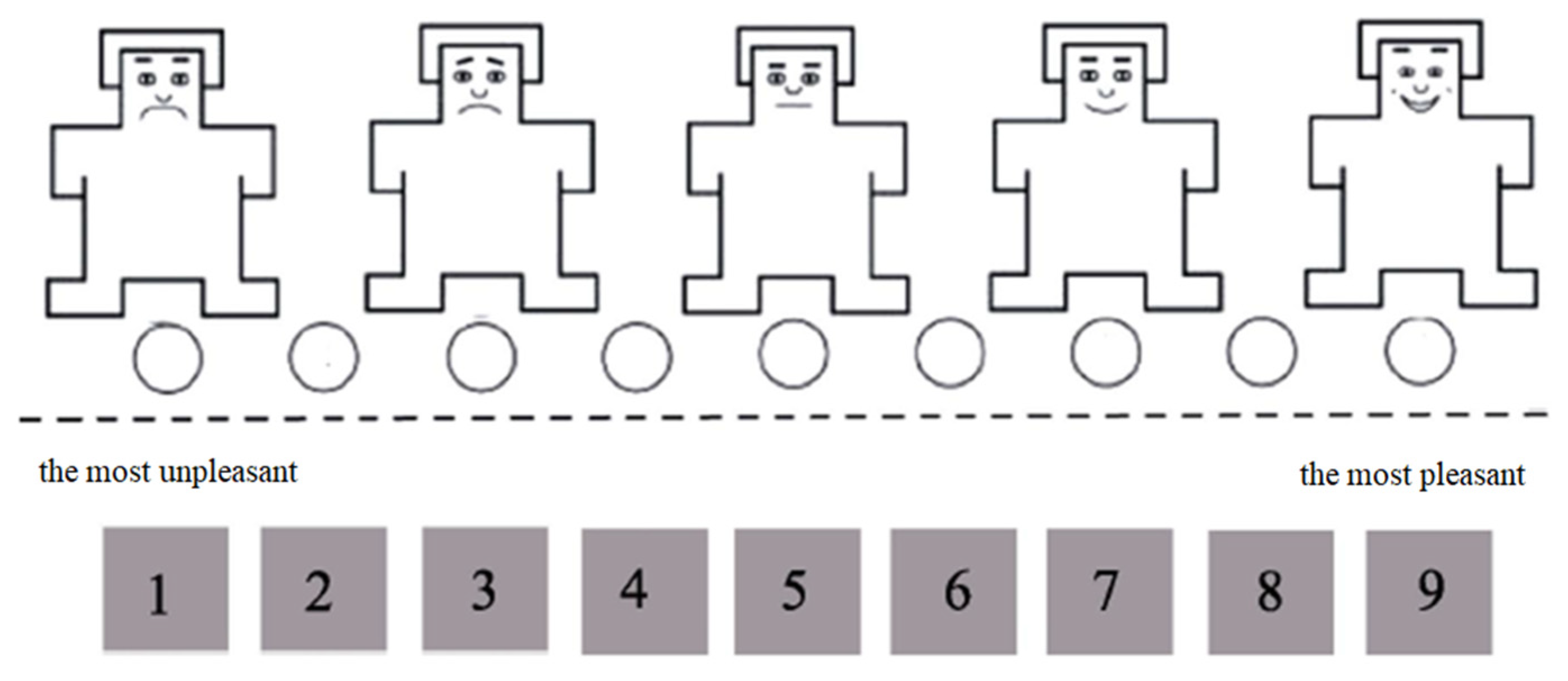
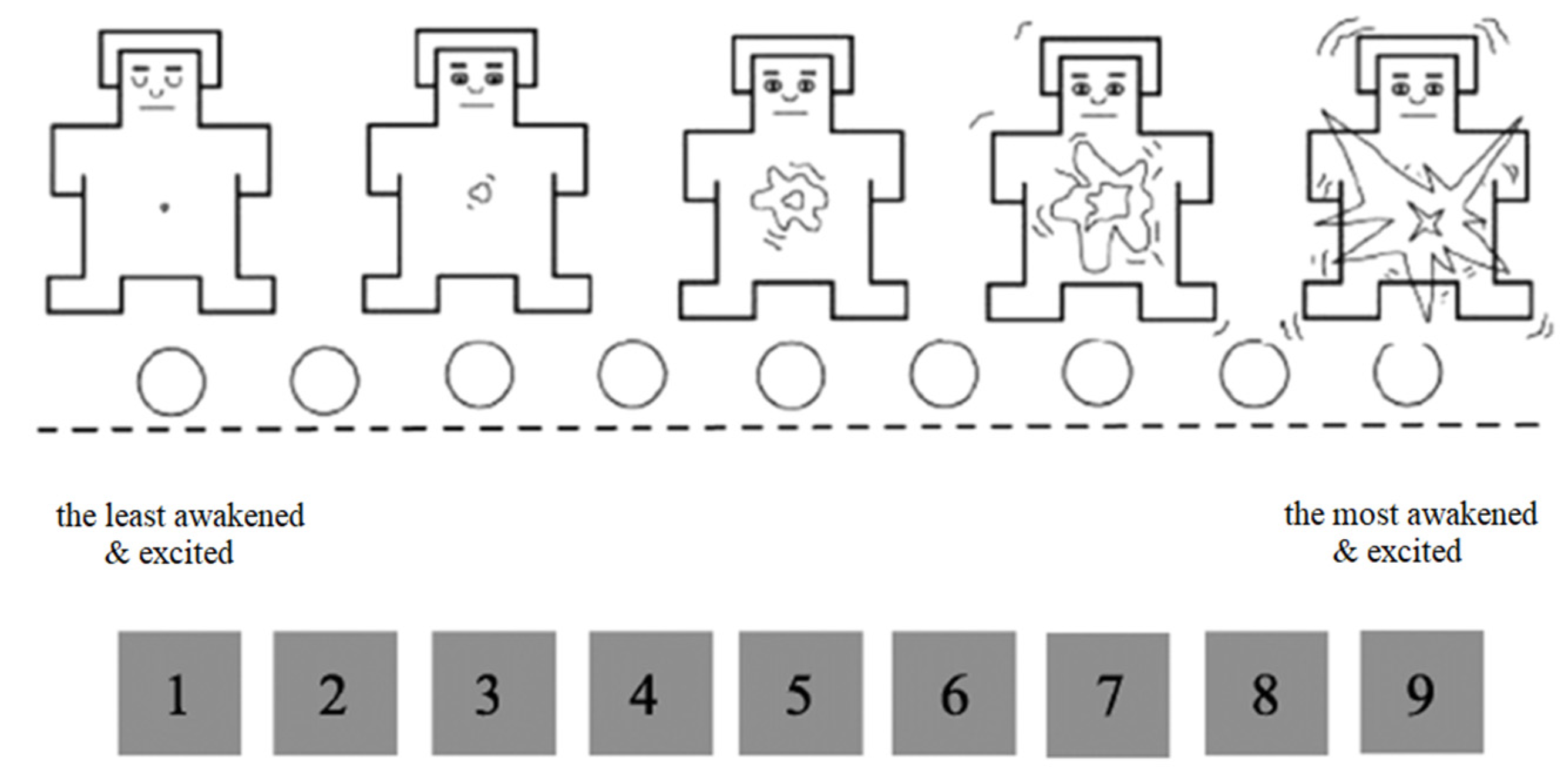
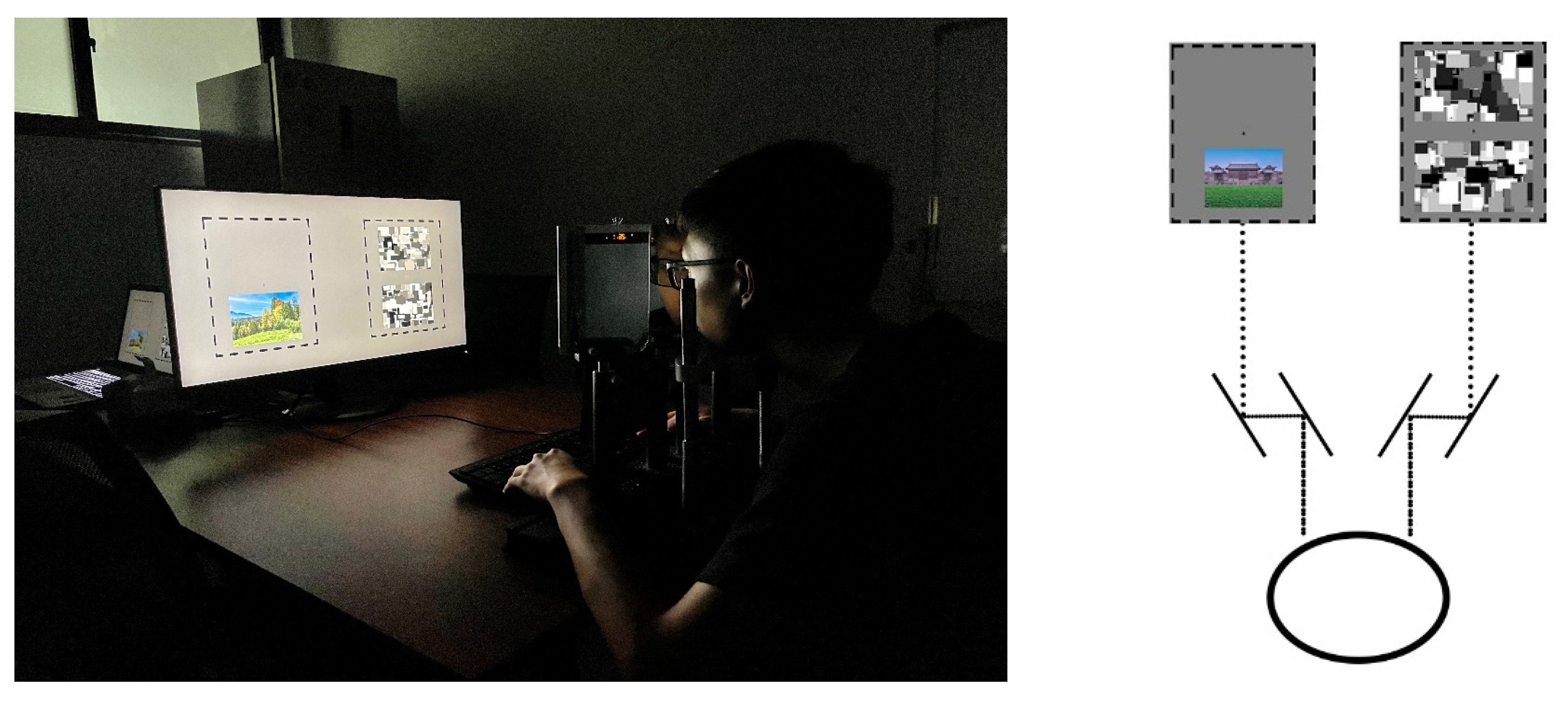
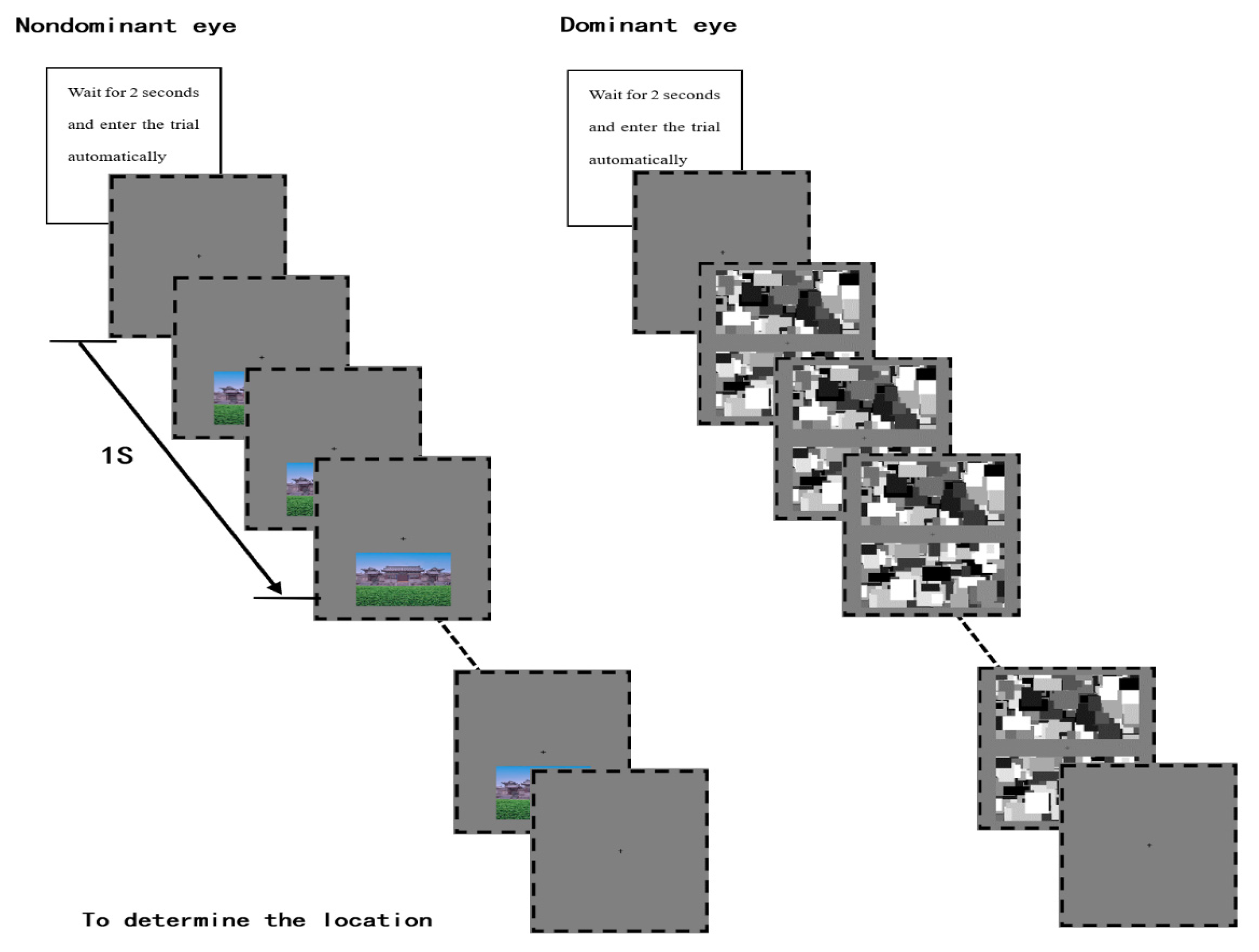
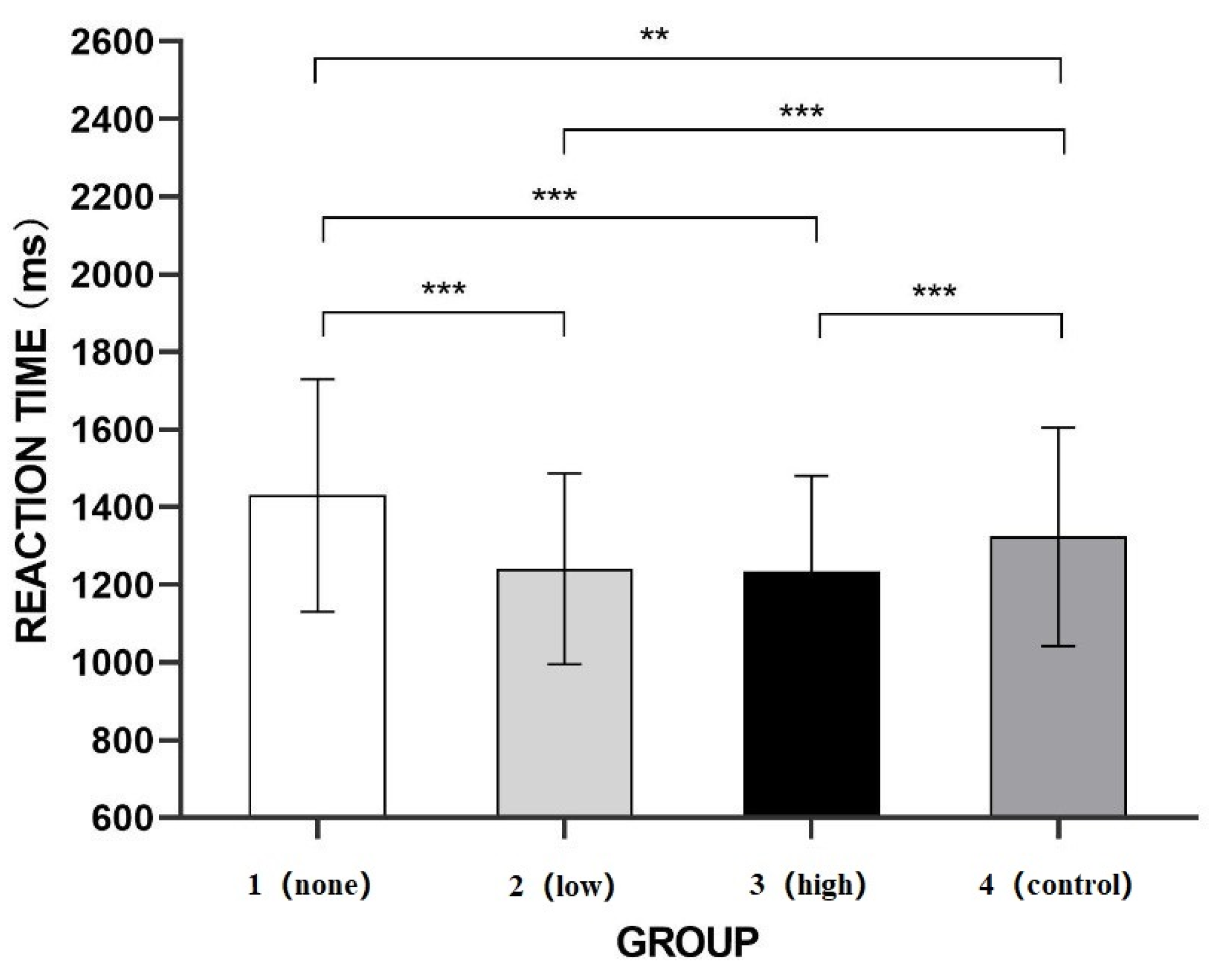

| Coverage of Greenery | Arousal | Pleasure | ||
|---|---|---|---|---|
| M | SD | M | SD | |
| None | 5.08 | 0.793 | 6.00 | 0.853 |
| Low | 5.58 | 0.669 | 6.42 | 0.996 |
| High | 5.33 | 0.779 | 6.08 | 1.311 |
| Control | 5.00 | 0.739 | 5.75 | 0.866 |
Disclaimer/Publisher’s Note: The statements, opinions and data contained in all publications are solely those of the individual author(s) and contributor(s) and not of MDPI and/or the editor(s). MDPI and/or the editor(s) disclaim responsibility for any injury to people or property resulting from any ideas, methods, instructions or products referred to in the content. |
© 2023 by the authors. Licensee MDPI, Basel, Switzerland. This article is an open access article distributed under the terms and conditions of the Creative Commons Attribution (CC BY) license (https://creativecommons.org/licenses/by/4.0/).
Share and Cite
Huang, X.; Jiang, H.; Lv, M. Unconscious Processing of Greenery in the Tourism Context: A Breaking Continuous Flash Suppression Experiment. Int. J. Environ. Res. Public Health 2023, 20, 2144. https://doi.org/10.3390/ijerph20032144
Huang X, Jiang H, Lv M. Unconscious Processing of Greenery in the Tourism Context: A Breaking Continuous Flash Suppression Experiment. International Journal of Environmental Research and Public Health. 2023; 20(3):2144. https://doi.org/10.3390/ijerph20032144
Chicago/Turabian StyleHuang, Xiang, Hao Jiang, and Ming Lv. 2023. "Unconscious Processing of Greenery in the Tourism Context: A Breaking Continuous Flash Suppression Experiment" International Journal of Environmental Research and Public Health 20, no. 3: 2144. https://doi.org/10.3390/ijerph20032144
APA StyleHuang, X., Jiang, H., & Lv, M. (2023). Unconscious Processing of Greenery in the Tourism Context: A Breaking Continuous Flash Suppression Experiment. International Journal of Environmental Research and Public Health, 20(3), 2144. https://doi.org/10.3390/ijerph20032144







